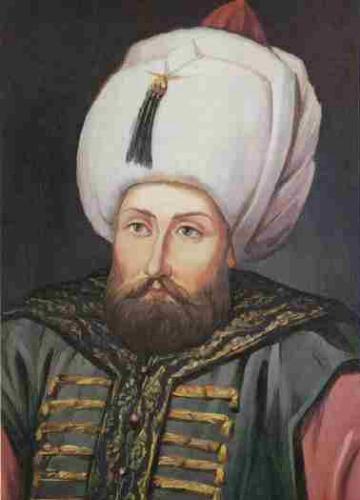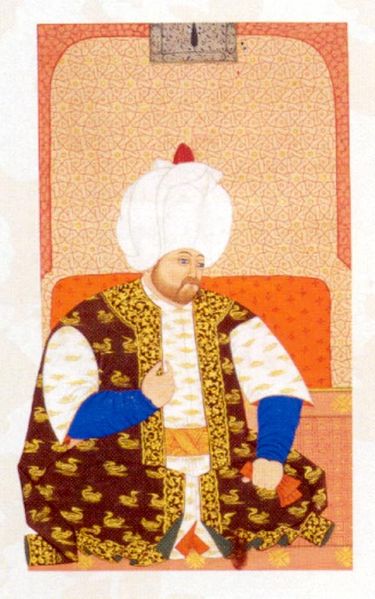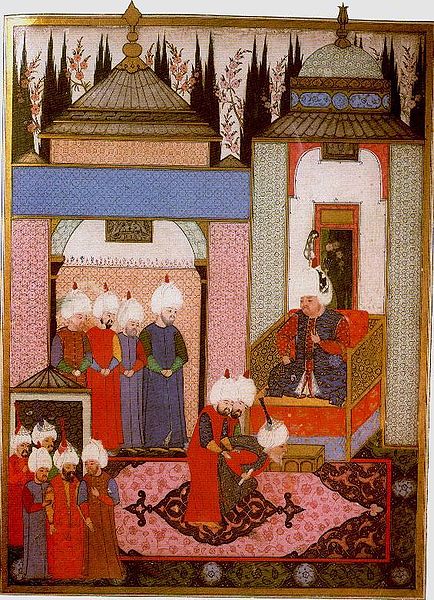<Back to Index>
- Sultan of the Ottoman Empire Selim II, 1524
PAGE SPONSOR



Selim II (Ottoman Turkish: سليم ثانى Selīm-i sānī, Turkish: II.Selim; 28 May 1524 – 12 December / 15 December 1574), also known as "Selim the Sot (Mest)" or "Selim the Drunkard"; and as "Sarı Selim" or "Selim the Blond", was the Sultan of the Ottoman Empire from 1566 until his death in 1574.
He was born in Constantinople a son of Suleiman the Magnificent and his fourth and favorite Ruthenian wife Hürrem Sultan (Roxelana).
In 1545, at Konya, he married Nurbanu Sultan, originally named Cecilia Venier - Baffo, a Venetian noblewoman, and mother of Murad III, who later became the first Valide Sultan who acted as co-regent with the sultan in the Sultanate of Women.
After gaining the throne after palace intrigue and fraternal dispute, succeeded as Sultan on 7 September 1566, Selim II became the first Sultan devoid of active military interest and willing to abandon power to his ministers, provided he was left free to pursue his orgies and debauches. Therefore, he became known as Selim the Drunkard or Selim the Sot (Turkish: Sarhoş Selim). His Grand Vizier, Mehmed Sokollu, a Bosnian devsirme from what is now Bosnia and Herzegovina, controlled much of state affairs, and two years after Selim's accession succeeded in concluding at Constantinople an honorable treaty (17 February 1568) with the Habsburg Holy Roman Emperor, Maximilian II, whereby the Emperor agreed to pay an annual "present" of 30,000 ducats and essentially granted the Ottomans authority in Moldavia and Walachia.
Against Russia Selim
was less fortunate, and the first encounter between the Ottoman Empire
and her future northern rival gave presage of disaster to come. A plan
had been prepared in Constantinople for uniting the Volga and Don by a canal, and in the summer of 1569 a large force of Janissaries and cavalry were sent to lay siege to Astrakhan and begin the canal works, while an Ottoman fleet besieged Azov.
But a sortie of the garrison of Astrakhan drove back the besiegers; a
Russian relief army of 15,000 attacked and scattered the workmen and the Tatar force sent for their protection; and finally, the Ottoman fleet was destroyed by a storm. Early in 1570 the ambassadors of Ivan IV of Russia concluded at Constantinople a treaty which restored friendly relations between the Sultan and the Tsar.
Expeditions in the Hejaz and Yemen were more successful, but the conquest of Cyprus in 1571, which provided Selim with his favorite vintage, led to the calamitous naval defeat against Spain and Italian states in the Battle of Lepanto in the same year, freeing the Mediterranean Sea from corsairs.
The Empire's shattered fleets were soon restored (in just six months; it consisted of about 150 galleys and 8 galleasses) and the Ottomans maintained control of the Mediterranean (1573). In August 1574, months before Selim's death, the Ottomans regained control of Tunisia from Spain who had controlled it since 1572.
Scottish historian Lord Kinross, in his The Seeds of Decline, sees the massive outlay for the fleet rebuilding following the Battle of Lepanto as the start of the Empire's slow decay. Kinross also says that Selim's reputation for drunkenness was solidified in his decision to invade Cyprus rather than supporting the Morisco Revolt (1568 – 1571) in Granada as well as in the manner of his death; Selim died in the Topkapı Palace after a period of fever brought on when he drunkenly slipped over on the wet floor of an unfinished bath house, getting a head injury.